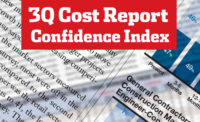Construction is a cyclical industry, and firms generally anticipate its ups and downs. However, the market has been steadily growing for the past eight years, and industry executives now believe that 2018 will be another good year. But few are as confident about the long term.
The near-term optimism, blunted by a longer-term market concern, can be seen in the results of the ENR Construction Industry Confidence Index survey, which rose five points, to 71, in the fourth quarter. Of the 235 executives of large construction and design firms responding to the survey, most believe market growth will continue in 2018.
But beyond that, the execs are less optimistic. For example, only 13% think the market will be in decline in 12 to 18 months, compared to 39% who say it will be in growth mode. But, in three years, 29% expect a market decline, compared to 22% who believe it still will be growing.
The CICI measures executive sentiment about the current market and where it will be in the next three to six months and over a 12- to 18-month period. A reading above 50 indicates a growing market.
The index is based on responses to surveys sent out between Nov. 9 and Dec. 12 to more than 6,000 U.S. firms on ENR’s lists of general contractors, subcontractors and design firms.
CFMA Index: CFOs Wary
The soon-to-be-released results of the latest Confindex survey from the Construction Financial Management Association, Princeton, N.J., show that execs believe the market and economy will remain healthy through the end of 2018 but are cautious about the overall strength of the 2019 market.
Each quarter, CFMA polls 200 CFOs from general and civil contractors and subs. The CFMA Confindex is based on four separate financial and market components, each rated on a scale of one to 200. A rating of 100 indicates a stable market; higher ratings show market growth is anticipated.
“The overall Confindex remained unchanged at 124 in the current quarter compared to last quarter,” says Stuart Binstock, CEO of CFMA. However, only two of Confindex’s four components also rose in the fourth quarter.
The “general business conditions” component rose two points, to 130, as did the “current conditions” component. However, the “year-ahead outlook” fell three points, to 117, Binstock says, while the “financial conditions” component fell two points, to 119.
Some of CFMA’s concerns relate to the continuing delay in an infrastructure bill from Washington. Binstock says hopes are becoming dimmer as time passes, despite the president’s promise to unveil an infrastructure plan in January.
There also are economic considerations that the upcoming tax-cut package may add to the deficit. “Fiscal hawks are not going to be eager to pass a major infrastructure funding bill that would add to projected deficits,” says Anirban Basu, CEO of economic consultant Sage Policy Group Inc., Baltimore.
Basu also notes that the CFMA respondents are primarily CFOs who are less focused on market growth and more concerned with economic conditions that affect profitability. So, the Confidex ratings were less exuberant than ENR’s CICI.
Another area of concern is inflation. Each quarter, ENR’s survey asks respondents whether they have seen materials and equipment price rises. This quarter, 76.6% said they have seen rising materials prices, higher than in the past.
Further, there are fears of wage inflation. ENR asked firms whether they had hiring plans in 2017 and what level of raises they planned to give next year. Nearly 80% said they planned to add to staff.
The average planned salary increase among the 191 firms answering the question was 4.15%. Basu notes that, with the addition of benefits, the average total compensation package increases could near 5% for industry firms.
ENR also asked what jobs firms wanted to fill. Of the 187 firms that answered, 91 said they were seeking project managers or superintendents, 52 firms were seeking craft labor, and 47 were seeking engineers.
Slowdown in Buildings
Optimism in the vertical markets by survey respondents sagged in the fourth quarter. The retail sector continues to take a beating, with a CICI rating of 38, down three points and by far the lowest level of market confidence of the 15 sectors measured by the survey.
Also down were the previously hot warehouse-and-distribution sector, which fell six points, to 68; K-12 education, down five points, to 61; higher education, down four, to 57; and multi-unit residential, down one, to 55. The health-care sector rose two points, to 71, and hotels and hospitality rose four, to 62.
On the other hand, transportation was up two points, to 71, now tied as the market with the most short-term potential. Further, water and wastewater rose three points, to a 69 rating.
The biggest gainer was the petroleum market—up 14 points, to a 70 rating. The industrial process and manufacturing sector was up four points, to 71, and power also rose four points, to 66.
The market looks healthy for 2018. But Binstock warns that, while top-line growth may look good, company executives should pay attention to their CFOs’ advice and keep their eye on the bottom line, too.




Post a comment to this article
Report Abusive Comment